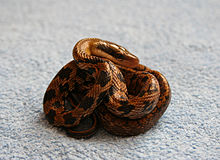The thin-tailed climbing snake [1] ( Elaphe taeniurus ) is a non-poisonous snake of the family of the pre-shaped .
| Thin-tailed climbing snake | ||||||||||||||
|---|---|---|---|---|---|---|---|---|---|---|---|---|---|---|
 | ||||||||||||||
| Scientific classification | ||||||||||||||
| ||||||||||||||
| Latin name | ||||||||||||||
| Elaphe taeniurus ( Cope , 1861) | ||||||||||||||
| Synonyms | ||||||||||||||
|
The total length reaches 195 cm. The head is poorly delimited from the neck. The tail is short. On top of the light lilac color with two thin black longitudinal lines that are connected to each other by transverse stripes, separated from each other by equal intervals. This combination of lines forms a characteristic pattern in the form of a ladder, which disappears in the back of the back. On the sides of the body are 2-3 rows of black spots, turning into stripes in the back of the body. The tail is black, with four whitish or yellowish stripes: one in the middle from the top, the other in the middle line from the bottom and along one strip is located on the lateral surface. The belly is yellow with dark spots.
He loves mountainous and lowland forests, open areas with grassy vegetation, manors, vegetable gardens near human habitation. Active day. It feeds on rodents smaller than rats, birds.
This is an egg-laying snake. The female lays 10–13 eggs in June – July.
He lives in Southeast Asia, China, Korea, Japan.
Perhaps in Primorsky Krai of Russia: In 1862 (one year after the species was described, based on a sample from Ningbo, Zhejiang Province, China), one fine-tailed snake species (Elaphe taeniurus taeniurus) was found on the shore of Novgorod Bay, Posyet Bay, Primorsky Krai. Since then, there has not been a single documented find of the Small-tailed Rider in the Primorsky Territory. It is assumed that this instance came ashore with cargo transported from China by sea.
At the moment, specific habitats are described for all subspecies of the small-tailed runner (approximately 13 pieces). Not one area crosses or even comes close to the border of the Russian Federation, some subspecies are island endemics. It is assumed that at the moment of inclusion of the small-tailed runner in the Red Book of the USSR, the Ministry of Natural Resources was guided only by the fact of the find, without using scientific works, because at the time of describing the find, no subspecies existed. Nevertheless, several years later, other subspecies of the small-tailed snake and their habitats were described (1879,1885, 1895, 1899, 1927). [2] , [3] , [4] . Thanks to the work of Oksana Skolina, the “Big Red Book”, the thin-tailed snake since 2014 has been in status for exclusion from the Red Book of the Russian Federation and is waiting only for an official reprint.
The nominative subspecies is also induced in East Flanders (Belgium).

Notes
- Ань Ananyeva N. B. , Borkin L. Ya. , Darevsky I. S. , Orlov N. L. The Five-Language Dictionary of Animal Names. Amphibians and reptiles. Latin, Russian, English, German, French. / edited by Acad. V.E. Sokolova . - M .: Rus. lang., 1988. - p. 299. - 10 500 copies. - ISBN 5-200-00232-X .
- ↑ Elaphe taeniura . The Reptile Database. The appeal date is April 8, 2019.
- ↑ Small-tailed snake Elaphe taeniura | The Red Book of Russia. redbookrf.ru. The appeal date is April 8, 2019.
- ↑ Thin-tailed snake . cicon.ru. The appeal date is April 8, 2019.
Literature
- Dictionary of Dovіdnik іz zoologіі. - K., 2002.
- Akeret, B. 2003. Terrarienbepflanzung. Reptilia (Münster) 8 (2): 22-29
- Barone, S. 2003. Beauty Snakes. Reptilia (GB) (31): 34-38.